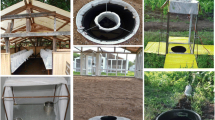Abstract
Laboratory and field studies were conducted on the oviposition behavior of the pathogen-vectoring mosquito, Culex quinquefasciatus, in response to the oviposition pheromone 6-acetoxy-5-hexadecanolide, produced from a renewable plant resource, Kochia scoparia (Chenopodiaceae) (plant-derived pheromone, PDP), and via an established synthetic route (synthetic oviposition pheromone, SOP). Responses to the oviposition cue skatole (3-methylindole), presented individually and in combination with the plant-derived and synthetic oviposition pheromone, were also studied. Both laboratory and field assays showed that PDP and SOP were equally attractive. Synergistic effects were observed with one combination of PDP and skatole combinations in laboratory assays. Synergy was also observed under field conditions. SOP and skatole combinations showed additive effects in laboratory assays, but were not tested in field bioassays. Although synergism has been previously demonstrated with combinations of SOP and polluted waters, the work presented here is the first example of synergy between a specific oviposition attractant and the oviposition pheromone. Furthermore, the efficacy of mosquito pheromone produced from a cheap, renewable botanical source has been demonstrated.
Similar content being viewed by others
REFERENCES
Beehler, J. W., Millar, J. G., and Mulla, M. S. 1994. Field evaluation of synthetic compounds mediating oviposition in Culex mosquitoes (Diptera, Culicidae). J. Chem. Ecol. 20:281–291.
Blackwell, A., Mordue (Luntz), A. J., Hansson, B. S., Wadhams, L. J., and Pickett, J. A. 1993. A behavioural and electrophysiological study of oviposition cues for Culex quinquefasciatus. Physiol. Entomol. 18:343–348.
Dawson, G. W., Mudd, A. L., Pickett, J. A., Pile, M. M., and Wadhams, L. J. 1990. Convenient synthesis of mosquito oviposition pheromone and a highly fluorinated analog retaining biological activity. J. Chem. Ecol. 16:1779–1789.
Donaldson, L. J. 2002. Getting Ahead of the Curve: A Strategy for Combating Infectious Diseases. UK Department of Health report, London.
Edwards, F. W. 1942. Mosquitoes of the Ethiopian Region III—Culicine Adults and Pupae. Adlard, London.
Gillett, J. D. 1972. Common African Mosquitoes and Their Medical Importance. William Heinemann Medical Books, London.
Jonsson, N. N. and Reid, S. W. J. 2000. Global climate change and vector-borne diseases. Vet. J. 160:87–89.
Laurence, B. R. and Pickett, J. A. 1982. erythro-6-Acetoxy-5-hexadecanolide, the major component of an oviposition attractant pheromone. Chem. Commun. 1:59–60.
Mboera, L. E. G., Mdira, K. Y., Salum, F. M., Takken, W., and Pickett, J. A. 1999. The influence of synthetic oviposition pheromone and volatiles from soakage pits and grass infusions upon oviposition site-selection of Culex mosquitoes in Tanzania. J. Chem. Ecol. 25:1855–1865.
Mboera, L. E. G., Takken, W., Mdira, K. Y., Chuwa, G. J., and Pickett, J. A. 2000a. Oviposition and behavioural responses of Culex quinquefasciatus to skatole and synthetic oviposition pheromone in Tanzania. J. Chem. Ecol. 26:1193–1203.
Mboera, L. E. G., Takken, W., Mdira, K. Y., and Pickett, J. A. 2000b. Sampling gravid Culex quinquefasciatus (Diptera, Culicidae) using traps baited with synthetic oviposition pheromone and grass infusions in Tanzania. J. Med. Entomol. 33:172–176.
Millar, J. G., Chaney, J. D., Beehler, J. W., and Mulla, M. S. 1994. Interaction of the Culex quinquefasciatus egg raft pheromone with a natural chemical associated with oviposition sites. J. Am. Mosq. Control Assoc. 10:374–379.
Millar, J. G., Chaney, J. D., and Mulla, M. S. 1992. Identification of oviposition attractants for Culex quinquefasciatus from fermented Bermuda grass infusion. J. Am. Mosq. Control Assoc. 8:11–17.
Mordue(Luntz), A. J., Blackwell, A., Hansson, B., Wadhams, L. J., and Pickett, J. A. 1992. Behavioural and physiological evaluation of oviposition attractants for Culex quinquefasciatus Say (Diptera: Culicidae). Experientia 48:1109–1111.
Olagbemiro, T. O., Birkett, M. A., Mordue (Luntz), A. J., and Pickett, J. A. 1999. Production of (5R,6S)-6-acetoxy-5-hexadecanolide, the mosquito oviposition pheromone, from the seed oil of the Summer Cypress plant, Kochia scoparia (Chenopodiaceae). J. Agric. Food Chem. 47:3411–3415.
Otieno, W. A., Onyango, T. O., Pile, M. M., Laurence, B. R., Dawson, G. W., Wadhams, L. J., and Pickett, J. A. 1988. A field trial of the synthetic oviposition pheromone with Culex quinquefasciatus Say (Diptera, Culicidae) in Kenya. Bull. Ent. Res. 78:463–470.
Pickett, J. A. and Woodcock, C. M. 1996. The role of mosquito olfaction in oviposition site location and in the avoidance of unsuitable hosts, pp. 109-123, in R. G.Bock and G.Cardew (eds.). Olfaction in Mosquito-Host Interactions. Wiley, Chichester, UK.
Pinheiro, F. 1997. Global situation of dengue and dengue haemorrhagic fever, and its emergence in the Americas. World Health Stat. Q. 3-4:161–169.
Reiter, P. 1983. A portable battery-powered trap for collecting gravid Culex mosquitoes. Mosq. News 43:496–498.
Reiter, P. 1986. A standardized procedure for the quantitative surveillance of certain Culex mosquitoes by egg raft collection. J. Am. Mosq. Control Assoc. 2:219–221.
Riesen, W. K., Milby, M. M., Presser, S. B., and Hardy, J. L. 1992. Ecology of mosquito and St. Louis encephalitis virus in Los Angeles basin of California. J. Med. Entomol. 29:582–598.
Turell, M. J., Sardelis, M. R., O'Guinn, M. L., and Dohm, D. J. 2002. Potential vectors of West Nile virus in North America, pp. 241–252, in J. S.McKenzie, A. D. T.Barrett, and V.Deubel (eds.). Current Topics in Microbiology and Immunology. Japanese Encephalitis and West Nile Viruses. Springer, Berlin.
WHO. 1992. Lymphatic Filariasis: The Disease and Its Control. WHO report, Geneva.
WHO/CTD. 1998. Malaria Prevention and Control. WHO report, Geneva.
Author information
Authors and Affiliations
Corresponding author
Rights and permissions
About this article
Cite this article
Olagbemiro, T.O., Birkett, M.A., (Luntz), A.J.M. et al. Laboratory and Field Responses of the Mosquito, Culex quinquefasciatus, to Plant-Derived Culex spp. Oviposition Pheromone and the Oviposition Cue Skatole. J Chem Ecol 30, 965–976 (2004). https://doi.org/10.1023/B:JOEC.0000028461.86243.19
Issue Date:
DOI: https://doi.org/10.1023/B:JOEC.0000028461.86243.19




